2025 August
Top Things to Do in Vientiane, Laos: the laid-back capital
(Map Included)
by Evi


Vientiane, the laid-back capital of Laos, might be one of Asia’s most relaxed cities. Unlike the chaotic buzz of other capitals, here you’ll find leafy boulevards, golden temples, French colonial buildings, and a calm riverside vibe. The city has a fascinating history: once part of the ancient Khmer Empire, later the capital of the Lao kingdom of Lan Xang, and influenced by French rule in the 19th century. Today, it’s a unique mix of Buddhist tradition, colonial charm, and modern development, making it the perfect place to start your Lao adventure.


1.Patuxay – The Victory Monument
Vientiane’s answer to Paris’s Arc de Triomphe, Patuxay was built in the 1960s to honor those who fought for independence from France. The name means "Victory Gate," and while it resembles its Parisian cousin, look closely and you’ll spot Lao touches, like mythological creatures and Buddhist motifs. You can climb to the top for panoramic views of the city, making it especially magical at sunset.
Opening Times: 8:30 AM - 5:30 PM if you want to climb to the towers.
2.Wat Si Muang Temple
This vibrant temple is beloved by locals and is said to house the guardian spirit of Vientiane. Legend has it that during construction in the 16th century, a pregnant woman sacrificed herself here to calm the restless spirits, her spirit is believed to still protect the city. People come to Wat Si Muang to pray for good luck, health, and prosperity.
3.Talat Sao (Morning Market)
A bustling mix of tradition and modernity, Talat Sao is Vientiane’s busiest market. You’ll find everything here: fresh produce, street food, traditional Lao textiles, electronics, and souvenirs. It’s not just for shopping—it’s also a glimpse into daily life in the capital. Don’t miss trying some local snacks while wandering the stalls!
Opening Times: 7 AM - 5 PM


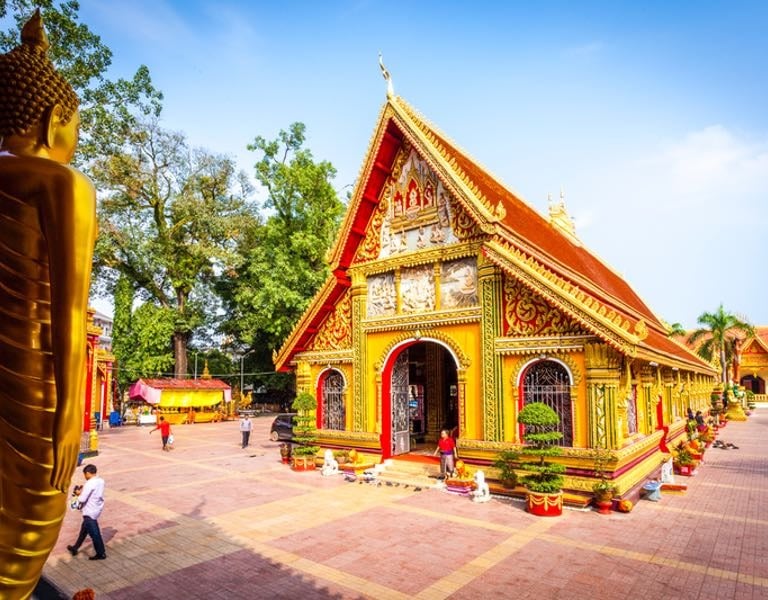



4.Pha That Luang
The most important national monument in Laos, Pha That Luang is a golden stupa that symbolizes Lao sovereignty and Buddhism. Originally built in the 3rd century and reconstructed in the 16th, it gleams in the sun and stands as a source of national pride. It is believed that a sacred relic, Buddha's breastbone, is enshrined into the stupa. Visiting here is like stepping into the spiritual heart of the country.
Opening Times: 8 AM - 5 PM
5.Buddha Park (Wat Xieng Khouane Luang)
About 25 km outside the city, Buddha Park is one of Vientiane’s quirkiest attractions. Although it is not a temple (wat), it may be referred to as Wat Xieng Khuan which means "spirit city". It was created in the 1950s by a priest-shaman who blended Buddhist and Hindu philosophies, resulting in a surreal garden of over 200 statues. You’ll see reclining Buddhas, multi-headed deities, and even climb inside a giant pumpkin sculpture representing heaven, earth, and hell.
Opening Times: 8 AM - 5 PM
Tip: You can visit Buddha Park With an organized tour like this one from Klook that also includes all the highlights of Vientiane.
6.Vientiane Night Market
Set along the Mekong River promenade, this market comes alive after sunset. It’s the perfect place to shop for souvenirs, try Lao street food, and enjoy the lively riverside atmosphere. While it’s more geared towards tourists, locals also come here to jog, cycle, and join in open-air aerobics classes. Combine it with a riverside beer at sunset for the ultimate evening.
Opening Times: 6 PM - 10 PM
Other Markets Worth Exploring
Khua Din Market – A local market full of fresh produce, spices, and daily goods.
Ban Anou Night Market – A more authentic night market, popular with locals and known for grilled meats and cheap eats. Opening Times: 5PM - 11PM


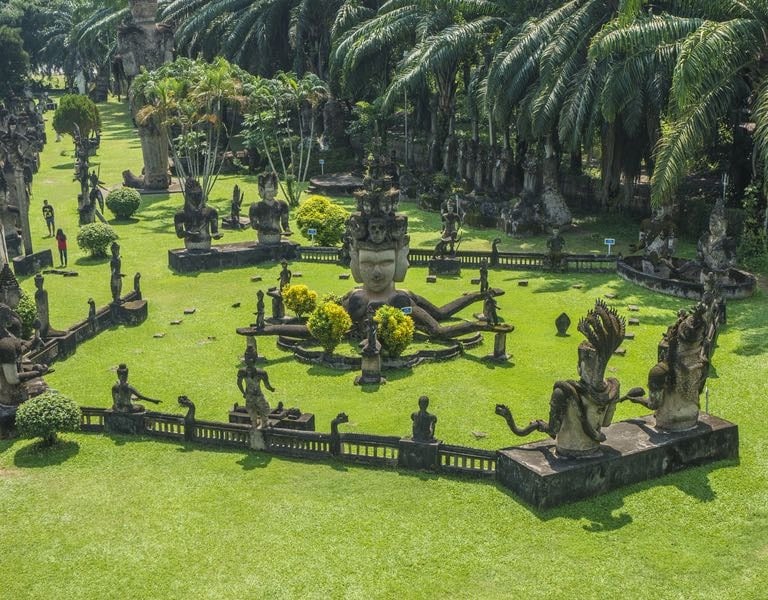

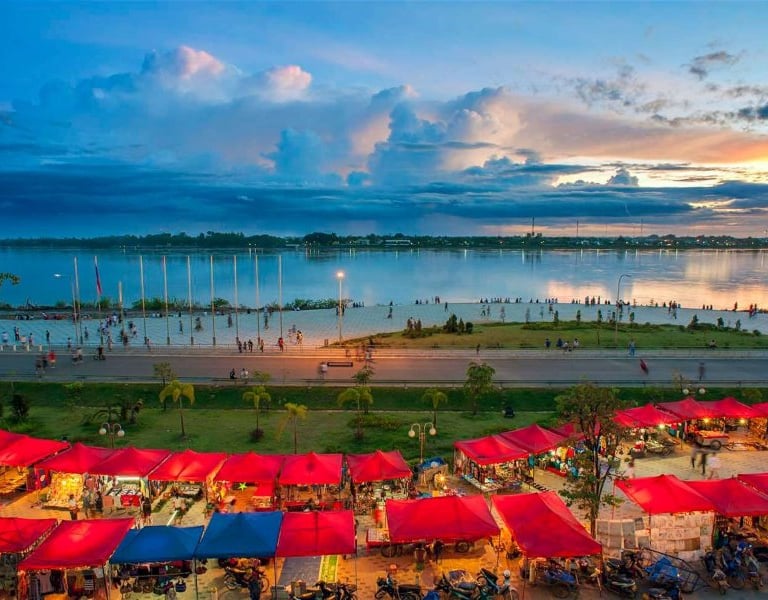

7.COPE Visitor Centre
One of the most meaningful places to visit in Vientiane, the COPE Visitor Centre tells the story of Laos as the most heavily bombed country per capita in history, due to the Vietnam War era. It’s both sobering and inspiring, showcasing the work being done to help victims of unexploded ordnance (UXO) through prosthetics and rehabilitation programs.
Opening Times: 8:30 AM - 5 PM
8.Wat Sisaket
Dating back to 1818, Wat Sisaket is the oldest surviving temple in Vientiane. It’s famous for its cloister walls filled with thousands of tiny Buddha images, over 6,800 in total! The temple’s unique Siamese-style architecture sets it apart from others in Laos, and it’s a peaceful place to wander and reflect.
Opening Times: 8:00 AM - 5 PM
9.Ho Phra Keo Museum
Once a royal temple built in 1565 to house the famous Emerald Buddha (now in Bangkok), Ho Phra Keo is now a museum of religious art. The temple itself is beautiful, with intricate carvings and a serene garden. While the Emerald Buddha is long gone, the site remains a cultural treasure.
Opening Times: 8:00 AM - 12 PM & 1 PM - 4 PM
10.That Dam Stupa (Black Stupa)
Right in the middle of a roundabout sits That Dam, an ancient, weathered stupa covered in moss. Legend says it was once covered in gold, but it was taken by the Siamese. Locals believe a seven-headed serpent (naga) once lived here to protect the city. It’s a mysterious and atmospheric sight, especially in the evening.
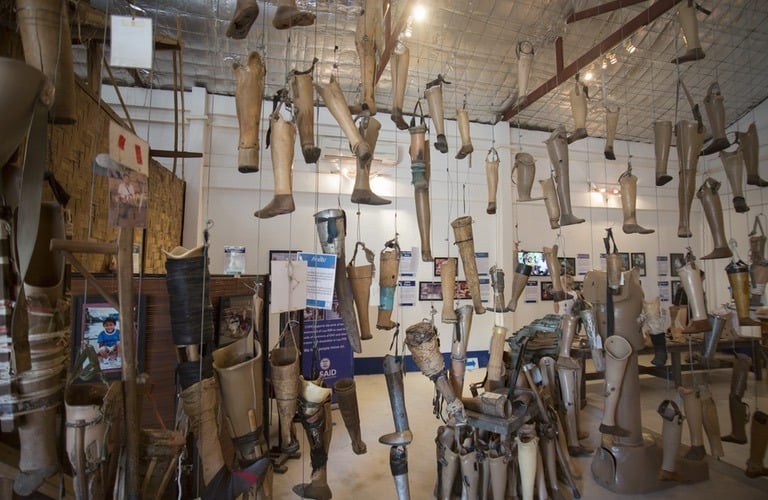

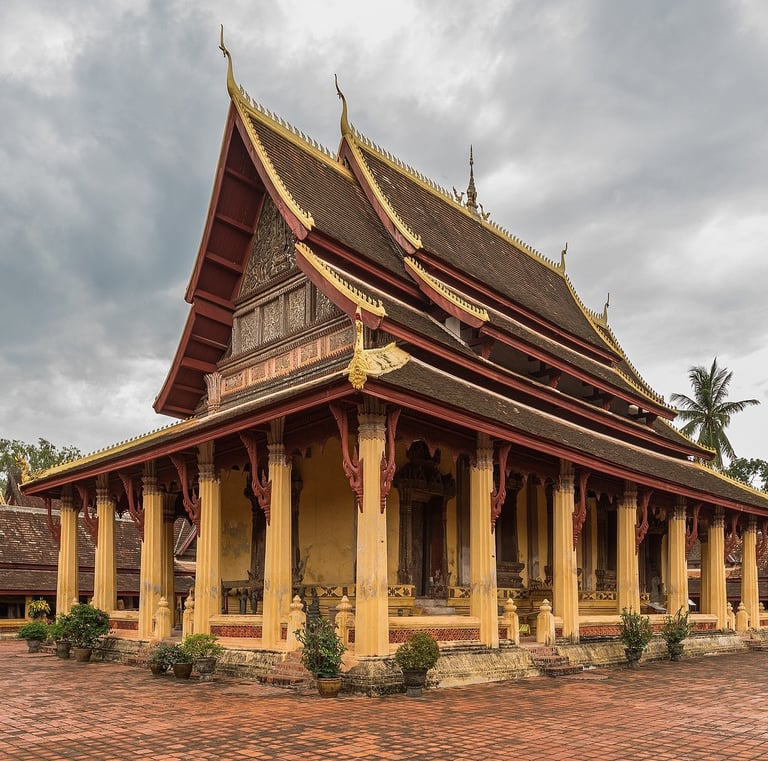

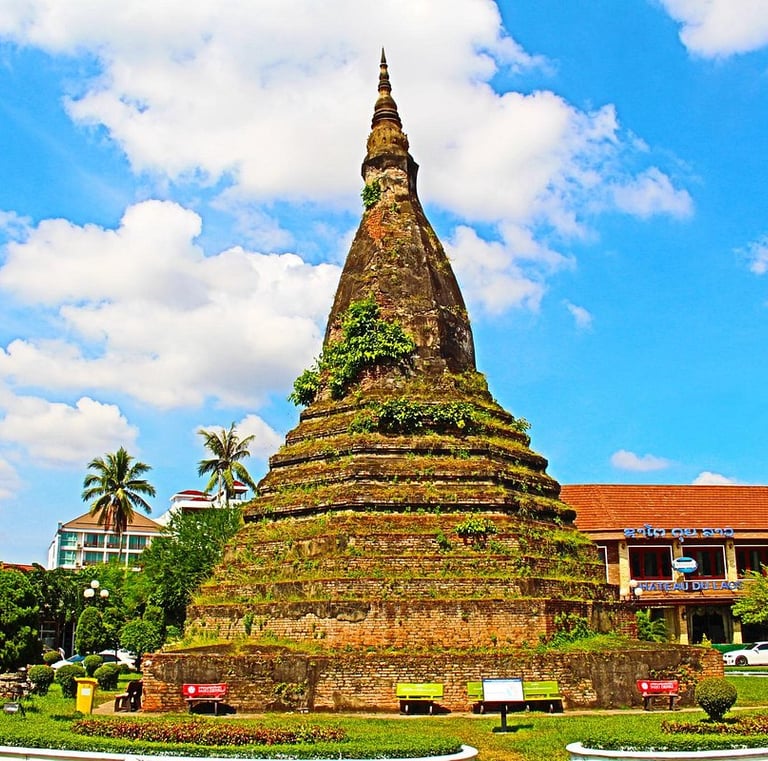

11.Samsenthai & Setthathirath Roads
These two central streets cut through Vientiane’s heart and are lined with cafés, French colonial buildings, temples, and boutique shops. They’re less hectic than most Asian capitals and perfect for wandering. You can easily pop into Wat Ong Teu or Wat Inpeng while strolling along.
12.Quai Fa Ngum Road
Running parallel to the Mekong, Quai Fa Ngum Road is a charming riverside street where you’ll find guesthouses, restaurants, and bars with sunset views. It’s quieter than the main promenade but just as atmospheric, with leafy trees and a laid-back vibe.
13.Witnessing Tak Bat in Vientiane
While Luang Prabang is the most famous place to see Tak Bat, the centuries-old morning almsgiving ritual, you can also experience it in Vientiane if you rise early. At dawn, local monks walk barefoot through the streets collecting sticky rice and small offerings from the faithful. One of the best places to witness it is around Wat Simuang and along Setthathirath Road, where several temples are located close together. Unlike the larger, more touristic ceremonies up north, Tak Bat in Vientiane feels quieter and more intimate, giving you a chance to observe respectfully without large crowds.


14.Try Lao Dishes in Vientiane
No trip to Vientiane is complete without diving into the bold, herb-packed flavors of Lao cuisine. Known for its balance of sour, spicy, salty, and bitter, Lao food is deeply tied to fresh herbs, sticky rice, and communal dining. Here are some classics you can’t miss while in the capital:
Larb – Often called the national dish of Laos, this minced meat salad (usually chicken, pork, beef, or fish) is flavored with lime, fish sauce, mint, and chili. It’s fresh, tangy, and best eaten with sticky rice.
Tam Mak Hoong – The Lao version of papaya salad, spicier and funkier than its Thai cousin thanks to fermented fish sauce (padek). A true street food staple.
Nam Khao (Lao Crispy Rice Salad) is one of Laos’ most beloved and unique dishes, a true must-try when visiting Vientiane or Luang Prabang.
Or Lam – A hearty stew from Luang Prabang made with vegetables, meat, and local herbs. Traditionally includes pepperwood, giving it a smoky flavor.
Khao Poon – A comforting noodle soup made with vermicelli in a fragrant coconut milk broth, often topped with chicken or fish.
Sai Oua – Lao-style herb sausages packed with lemongrass, kaffir lime leaves, and chili. You’ll smell them sizzling at markets before you see them.
Sticky Rice – The heart of every Lao meal. It’s eaten with nearly everything, rolled by hand into bite-sized balls.
Mok Pa – Fish seasoned with herbs and spices, wrapped in banana leaves, and steamed. A fragrant, delicate dish full of flavor.
Jaew Bong – A rich chili paste made with buffalo skin, perfect for dipping sticky rice or fresh veggies.
Lao Coffee – Strong, sweet, and often served with condensed milk. The Bolaven Plateau near Pakse produces some of the best beans in Southeast Asia.
15.Lao Massage – A Relaxing Must-Try
After a day of temple hopping and market strolling in Vientiane, there’s nothing better than unwinding with a traditional Lao massage. Similar to Thai massage but generally gentler, Lao massage focuses on acupressure, stretching, and improving energy flow through the body. Don’t expect oils or fancy spa beds, in many local parlors you’ll change into loose cotton clothes and lie on a simple mattress. The therapist uses hands, elbows, and sometimes feet to release tension, leaving you both relaxed and energized.
A one-hour session is very affordable (usually between 60,000–120,000 kip, about 3–6 euro), making it easy to indulge more than once during your trip. You’ll find massage shops all over Vientiane, especially around the riverfront night market area and near the city center temples. For a slightly more luxurious experience, boutique spas and hotels also offer oil massages and herbal treatments that combine relaxation with a touch of pampering.
Tip: Lao massage can be firm at times, don’t hesitate to let your therapist know if you’d like a lighter touch!


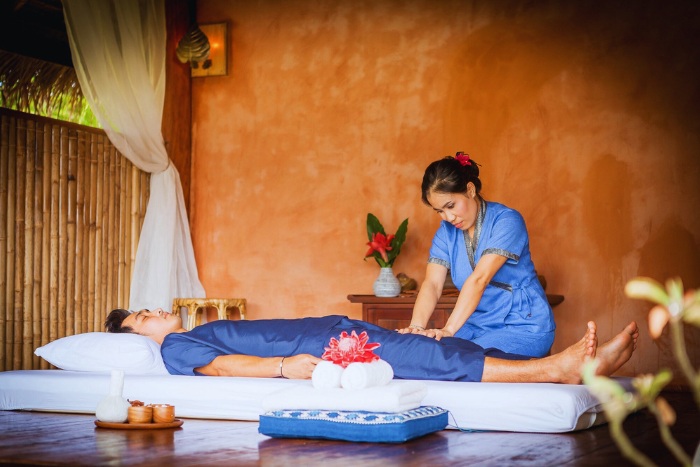

Pro Tip: Take a day Tour
If you’ve got just a few hours to explore Vientiane, a half-day guided tour, such as this highly rated from Klook, lets you cover key sights like Buddha Park, Patuxay Monument, and Pha That Luang with minimal hassle. These tours typically last around 4–5 hours and include hotel pickup, making them super-efficient for short-stay travelers. Instead of figuring out transport, tickets, and routes yourself, you get to enjoy the highlights with ease, a local driver and guide handle everything while you sit back, snap photos, and soak it all in.


Where to Eat & Drink in Vientiane
Vientiane might be laid-back compared to other capitals, but when it comes to food and drinks, it’s full of flavor and atmosphere. From local Lao classics to rooftop lounges and cozy cafés, the city offers plenty of great stops to fuel your adventures:
La Lune Restaurant – A chic spot blending Lao flavors with Western influences. Perfect for when you want a modern take on traditional dishes in an elegant setting.
Tipsy Elephant Vientiane Rooftop Lounge – A favorite for sundowners. Come for the cocktails, stay for the skyline views and bar bites.
525 Eat & Drink – Stylish yet welcoming, this place mixes creative cuisine with signature drinks, ideal for a night out that balances food and fun.
The Wine Cafe – A go-to for tapas and a carefully curated wine list. Think European vibes in the heart of Vientiane.
Kung’s Café Lao / Laos Coffee Bachiang – Cozy, quirky, and delicious, this café is a must for trying their famous crab khao piak (Lao noodle soup).


Soukvimarn Cuisine Lao – A great pick for authentic dishes like Gaeng No Mai (bamboo shoot soup) and Larb(minced meat salad), cooked with traditional flair.
Khop Chai Deu – One of Vientiane’s most iconic restaurants and bars, buzzing with both locals and travelers. A good spot for Lao staples, international food, and late-night drinks.
Il Tavolo Simuang – When you’re craving Italian, this trattoria serves up hearty pastas and pizzas with warm hospitality.
Go Dunk – A vibrant bar-restaurant mixing tasty eats, strong drinks, and live music. A fun place to end your evening on a high note.
From casual cafés to rooftop cocktails, Vientiane’s food and drink scene is all about easy-going evenings with a tasty twist.
How to Get to Vientiane
Vientiane ⇄ Luang Prabang
By Train: The fastest and most comfortable way is the Laos–China Railway, connecting the capital to Luang Prabang in just 2 hours. Trains are modern, clean, and punctual. Tickets cost around 20–35 euro depending on class.
Book in person at the station, through local travel agencies, or online via 12go.asia.
By Bus: Overnight sleeper buses take 9–11 hours. Cheaper than trains (15 euro), but less comfortable.
By Plane: Laos Airlines and Lao Skyway run short flights (~45 minutes). Convenient, but usually more expensive than trains.
Vientiane ⇄ Pakse (Southern Laos)
By Plane: The quickest way (1 hr 30 min). Laos Airlines operates direct flights several times per week.
By Bus: Overnight buses take 10–12 hours. VIP or sleeper buses are the most comfortable option. You can book at local stations or on 12go.asia.
By Train: No train line yet to Pakse—flights or buses are the best bet.


Vientiane ⇄ Siem Reap/Phnom Penh (Cambodia)
By Plane: Laos Airlines and Cambodia Angkor Air operate direct flights (1–2 hours).
By Bus: Long but cheap option (~24 hours to Phnom Penh). Buses pass through Pakse and the Laos–Cambodia border crossing at Nong Nok Khiene.
Vientiane ⇄ Hanoi (Vietnam)
By Plane: Quick and easy (1 hr 10 min).
By Bus: Budget-friendly but long and tiring (22–24 hours). Popular with backpackers, but only recommended if you have the stamina.
How to Get Around Vientiane
Vientiane is a laid-back capital, but getting around is still simple. The city center and riverside area can easily be explored on foot or by bicycle, with plenty of rental shops and hotels offering bikes for free or at low cost.
For longer distances, tuk-tuks are the most common way to move around, just make sure to negotiate the fare before starting the ride. The LOCA and InDrive apps also work well here, providing a safer and more transparent option than haggling in the street, with payment available in cash or through the app.
If you want more independence, motorbike rentals are widely available, but traffic can feel a bit chaotic, so they’re best for confident riders (helmets are a must). To reach attractions outside the city like Buddha Park, Pha That Luang, or the countryside, you can hire a tuk-tuk for a few hours, book a driver through your hotel, or join a guided tour for convenience.


Staying Connected in Vientiane
Having internet access makes navigation, translation, and booking activities much easier. The easiest option is to get an eSIM before you arrive, using services like Revolut, Airalo or Nomad, which let you connect as soon as you land without visiting a store.
If you prefer a physical SIM card, local providers like Unitel, Lao Telecom, and ETL sell prepaid SIMs at the airport, convenience stores, and phone shops. Expect affordable packages with plenty of data for a week or more.
Most hotels, cafés, and restaurants offer free Wi-Fi, but speeds can vary, so a local SIM or eSIM ensures you stay connected even during day trips into the countryside.


Where to Stay in Vientiane
When it comes to accommodation in Vientiane, location really matters. The city is spread out, so it’s best to stay in the center, close to the Mekong riverside and the main sights like Patuxay, Talat Sao, and the night market. This way, you can walk to most attractions, enjoy the lively evening atmosphere, and avoid long tuk-tuk rides back and forth.
Chandara Boutique Hotel – A charming boutique option with cozy rooms and a peaceful atmosphere, while still being close to the city’s main attractions.
Green Park Boutique Hotel – A stylish stay that blends modern comfort with traditional Lao design, featuring a beautiful pool perfect for hot afternoons.
Settha Palace Hotel – A timeless Vientiane classic, offering colonial-style elegance, spacious rooms, and impeccable service for those who want to indulge.
Staying central not only saves you time and money but also lets you soak up the best of Vientiane’s riverside vibe—whether that’s sipping a drink at sunset, wandering the night market, or hopping easily between temples and museums.
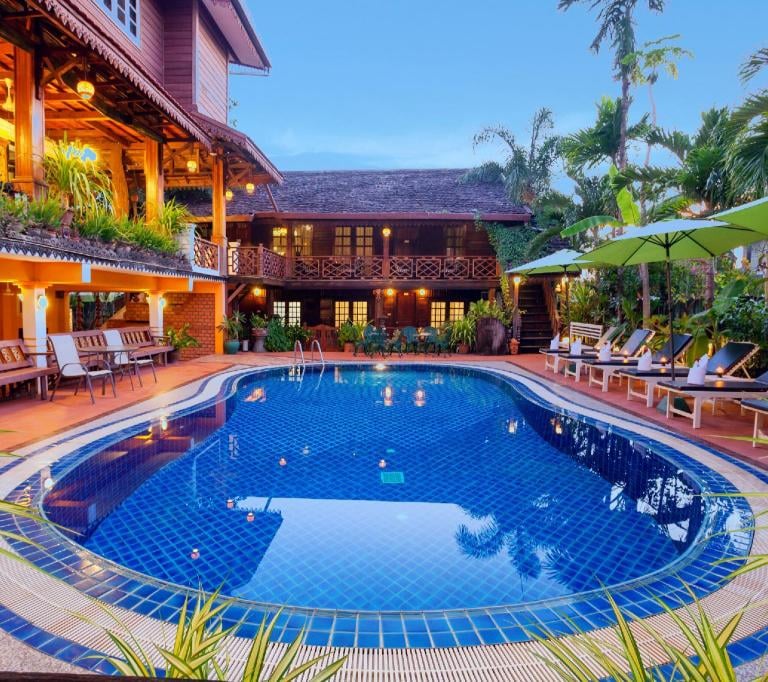

Vientiane is the perfect introduction to Laos’s soul.
Vientiane may not have the frantic energy of other Southeast Asian capitals, but that’s exactly its charm. Between its golden temples, French-colonial streets, quirky Buddha Park, and bustling markets, it’s a city that invites you to slow down and soak in the atmosphere. Whether you’re tracing history at Pha That Luang, climbing Patuxay, or enjoying the riverside night market, Vientiane is the perfect introduction to Laos’s soul.
Drop us a comment bellow
Check our other post for Laos
Top Things to Do in Vientiane, Laos: the laid-back capital (Map Included)
Vientiane, the laid-back capital of Laos, might be one of Asia’s most relaxed cities. Unlike the chaotic buzz of other capitals, here you’ll find leafy boulevards, golden temples, French colonial buildings, and a calm riverside vibe. The city has a fascinating history: once part of the ancient Khmer Empire, later the capital of the Lao kingdom of Lan Xang, and influenced by French rule in the 19th century. Today, it’s a unique mix of Buddhist tradition, colonial charm, and modern development, making it the perfect place to start your Lao adventure.
Evi
8/18/202512 min read
